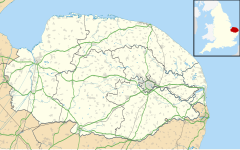world.wikisort.org - United_Kingdom
Brinton is a village and a civil parish in the English county of Norfolk.[2] The village is 10.8 miles east-north-east of the town of Fakenham, 13.1 miles west south-west of Cromer and 125 miles north-north-east of London. The nearest railway station is at Sheringham for the Bittern Line which runs between Sheringham, Cromer and Norwich. The nearest airport is Norwich International Airport.
| Brinton | |
|---|---|
 St Andrew Parish Church | |
 Brinton Location within Norfolk | |
| Area | 6.13 km2 (2.37 sq mi) |
| Population | 222 (Including Sharrington, 2011 census)[1] |
| • Density | 36/km2 (93/sq mi) |
| OS grid reference | TG030350 |
| • London | 125 miles (201 km) |
| Civil parish |
|
| District |
|
| Shire county | |
| Region | |
| Country | England |
| Sovereign state | United Kingdom |
| Post town | MELTON CONSTABLE |
| Postcode district | NR24 |
| Dialling code | 01263 |
| Police | Norfolk |
| Fire | Norfolk |
| Ambulance | East of England |
| UK Parliament | |
History
Brinton has an entry in the Domesday Book of 1086[3] under the name ‘’Bruntuna’’, and it is said to be in the ownership of Bishop William.
The villages name means 'Farm/settlement connected with Bryni'.
Description


The village is situated in a shallow valley and the dwellings site either side of quiet narrow lanes. In the village is Brinton Hall which was constructed in the Georgian era to replace an earlier 16th-century house. The house seen today was rebuilt in 1822 by Brereton family. The interior has a fine wainscot staircase, installed in 1911.[4] Award-winning work at Brinton Hall includes remodelling of the west front and renovation of all interior rooms. In the grounds there are formal gardens, the hall also has a walled kitchen garden with a hot greenhouse. The property is surrounded by parkland with ha-ha wall, lake, woods and meadows. The village and some of its houses were once used as a backdrop for the BBC television series Dangerfield.
Parish church
The parish church is dedicated to St Andrew and parts date back to the 14th century.[5] The church register dates from 1547. The church tower dates from c.1400 and has one bell. There is a statue of Saint Andrew in a niche above the transept which dates from the Medieval period. The statue only survives because it had been screened with plasterwork to hide it. It was rediscovered in 1871.
Notable people
- John Astley, Rector 1758–1803[6]
References
- "Parish population 2011". Retrieved 31 August 2015.
- OS Explorer Map 24 - Norfolk Coast Central. ISBN 0-319-21726-4.
- The Domesday Book, Englands Heritage, Then and Now, Editor: Thomas Hinde, Norfolk page 187 ISBN 1-85833-440-3
- Investigation of the history of Nelson's Staircase Archived 2008-11-20 at the Wayback Machine
- Norfolk 1: Norwich and North-East, By Nikolaus Pevsner and Bill Wilson, Brinton entry. ISBN 0-300-09607-0
- John Archibald Venn, Alumni Cantabrigienses: Part II. 1752–1900, Vol. I (1940), p. 88
Другой контент может иметь иную лицензию. Перед использованием материалов сайта WikiSort.org внимательно изучите правила лицензирования конкретных элементов наполнения сайта.
WikiSort.org - проект по пересортировке и дополнению контента Википедии